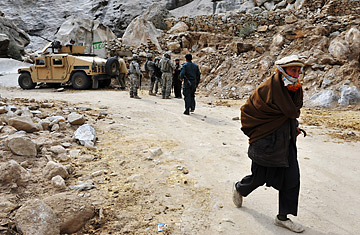
An elderly Afghan man passes U.S. soldiers on patrol in Nuristan province, Afghanistan, on Feb. 14, 2010
Every morning at 8, Maulawi Zahir heads into Waygal district center, a remote mountain village of stone houses stacked almost vertically up granite slopes. As the undeniable man in charge of the Afghan village, the Taliban leader is there to hear and settle disputes. But despite his group's ascendancy, he struggles to burnish his credentials among his constituents, even in an area where loathing for NATO and the Afghan government runs deep. "People aren't happy, but they pretend to be," says one local trader. "They dislike the Taliban as much as they dislike government."
Zahir's attempt at daily dispute resolution is important in one respect: for the first time in almost a decade the Taliban are administering an Afghan district unmolested. In fact, Waygal has been almost completely abandoned by NATO for the past three years. For the insurgents — and their non-Afghan militant allies from Pakistan and Arabic-speaking countries — it is the most visible step in a longer term strategy to turn Nuristan, itself virtually given up by the alliance since 2009, into a militant hub and a staging post for attacks on strategic targets, including the capital, Kabul.
Still, it is hard going for the Taliban. Local commanders don't exactly have the same agendas as the foreign fighters with visions of global jihad. Elsewhere in the province, on occasions when the militants have massed, Afghan government commandos and their U.S. mentors have scrambled from bases lower down the valleys to disperse them. Last Wednesday, as Taliban fighters attempted to storm Du Ab district center in Nuristan's west, U.S. warplanes killed more than 100 in a series of bombing runs, reportedly including civilians and a convoy of Afghan police. After NATO bombs killed several children in southern Helmand province on Sunday, President Hamid Karzai complained loudly. NATO apologized for the civilian casualties. Karzai has yet to comment on the Du Ab strike although his government has been broadly supportive of the Nuristan campaign, with the Interior Ministry promising to reclaim areas lost to the Taliban.
NATO is quick to point out that the sustained fighting in Nuristan is a testament to the toughness of the Afghan police on the front lines. That is undoubtedly true, but it misses the point that the Taliban attacks are part of a rolling effort to drive the government out of Nuristan altogether. The Taliban has three objectives in mind: to take Nuristan; storm Asadabad, capital of neighboring Kunar province; and undermine NATO's plans to hand a third territory, Laghman province, over to the Afghan government.
"The number of attacks has been shooting up," says a Western security analyst. "Bases are getting smashed, there are [illegal] checkpoints on the road every day." On May 1, when the Taliban announced their nearly nationwide spring campaign, Asadabad bore the brunt of the assault: three mortar attacks on a U.S. base in 36 hours and assaults on the prison and police headquarters, in what may well have been a hint of things to come.
Indeed, history is not on NATO's side. The 1978 uprising by landowners and clerics, which led to civil war, the virtual collapse of the government and ultimately the Soviet invasion of Afghanistan, began in eastern Nuristan and spread quickly to Kunar. "Trouble here can break the central government," said Qari Ziaur Rahman, a regional commander for the Taliban who is also a leader of the Punjab-based militant group Jaish-e-Muhammad, in a 2008 interview. "Whoever has been defeated in Afghanistan, his defeat began from Kunar." Whether the Taliban and their allies can pull off a successful assault on Asadabad is questionable, but there seems little doubt they'll try. For its part, NATO has redeployed troops to the valley linking Waygal with Asadabad in what looks like an attempt to lock the door.
